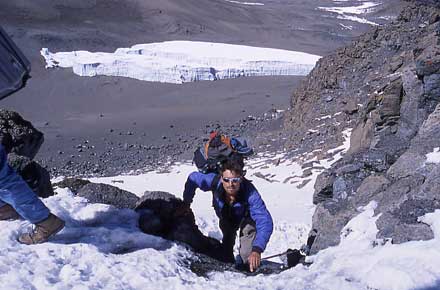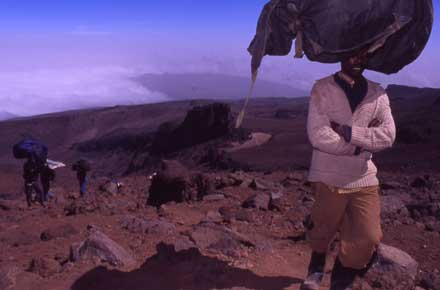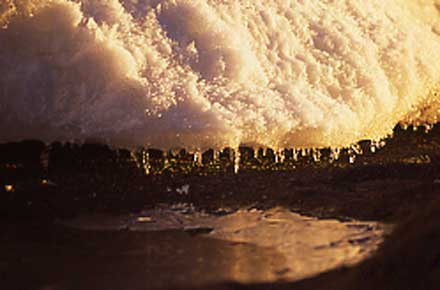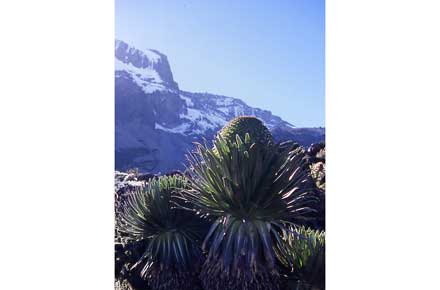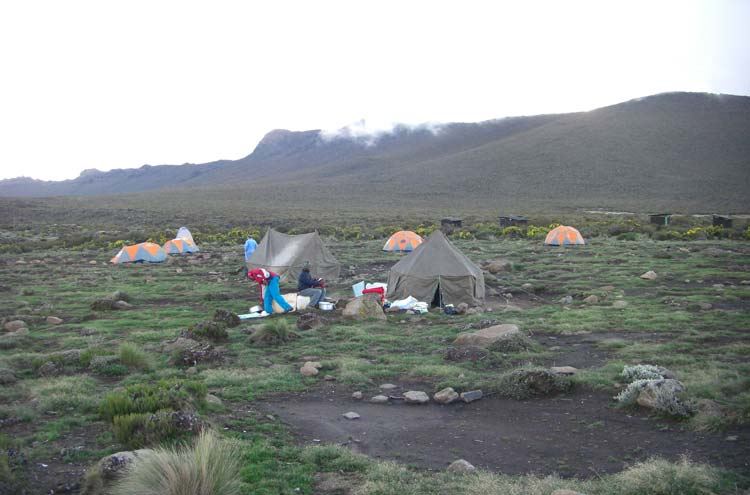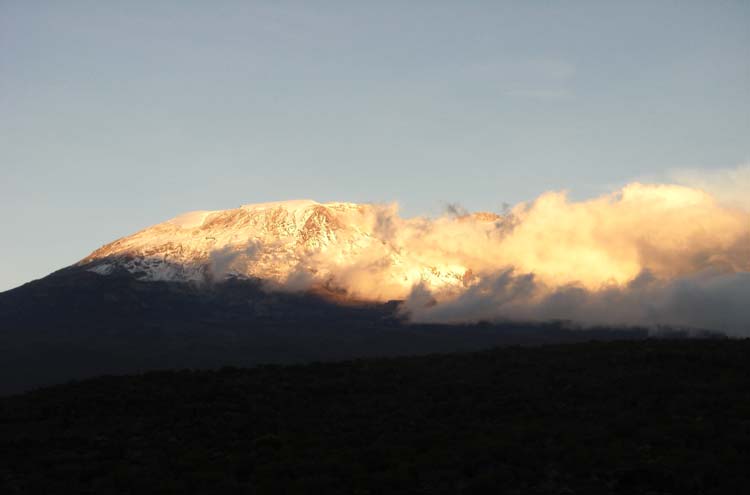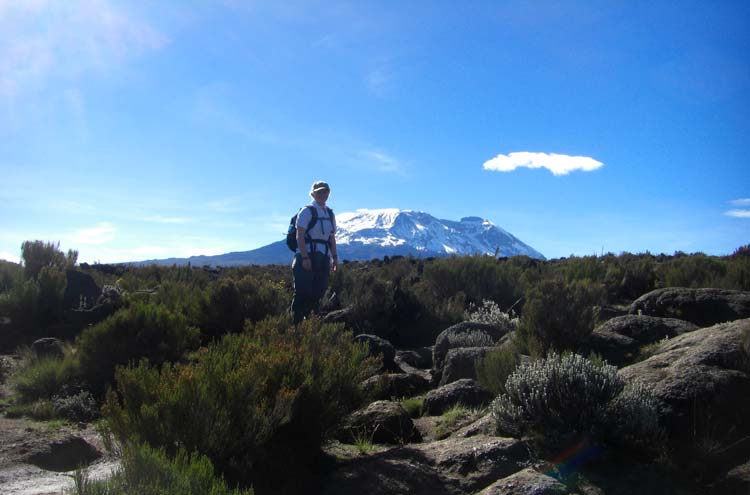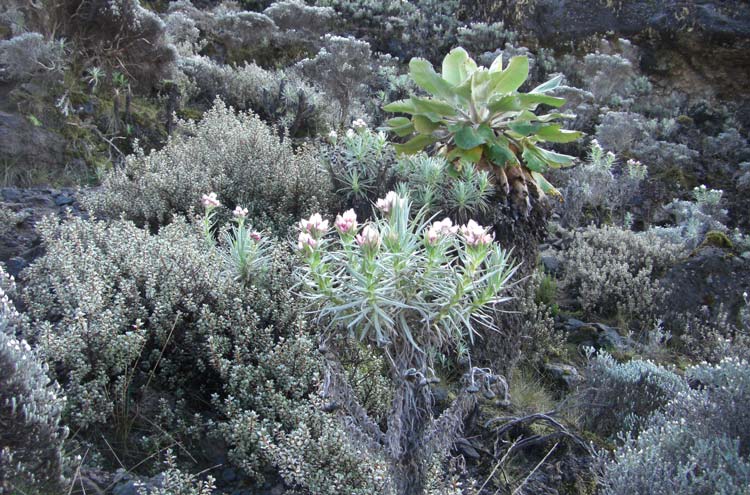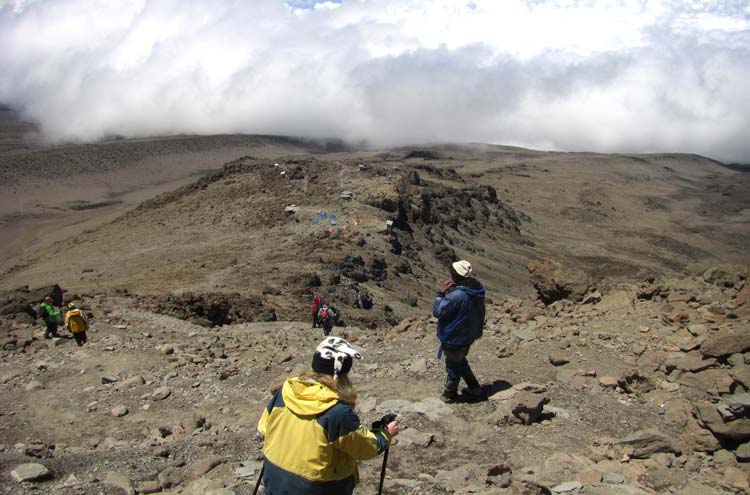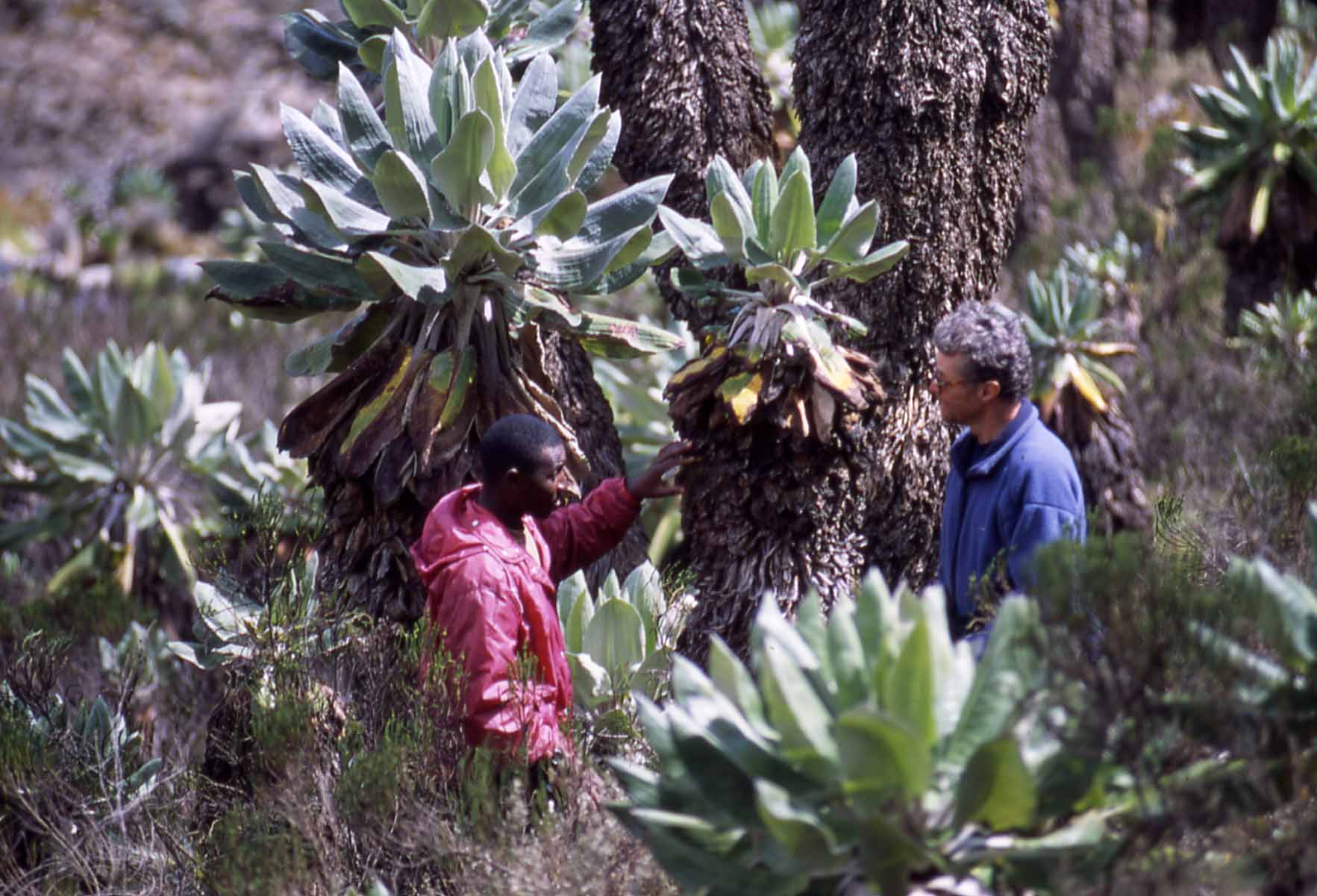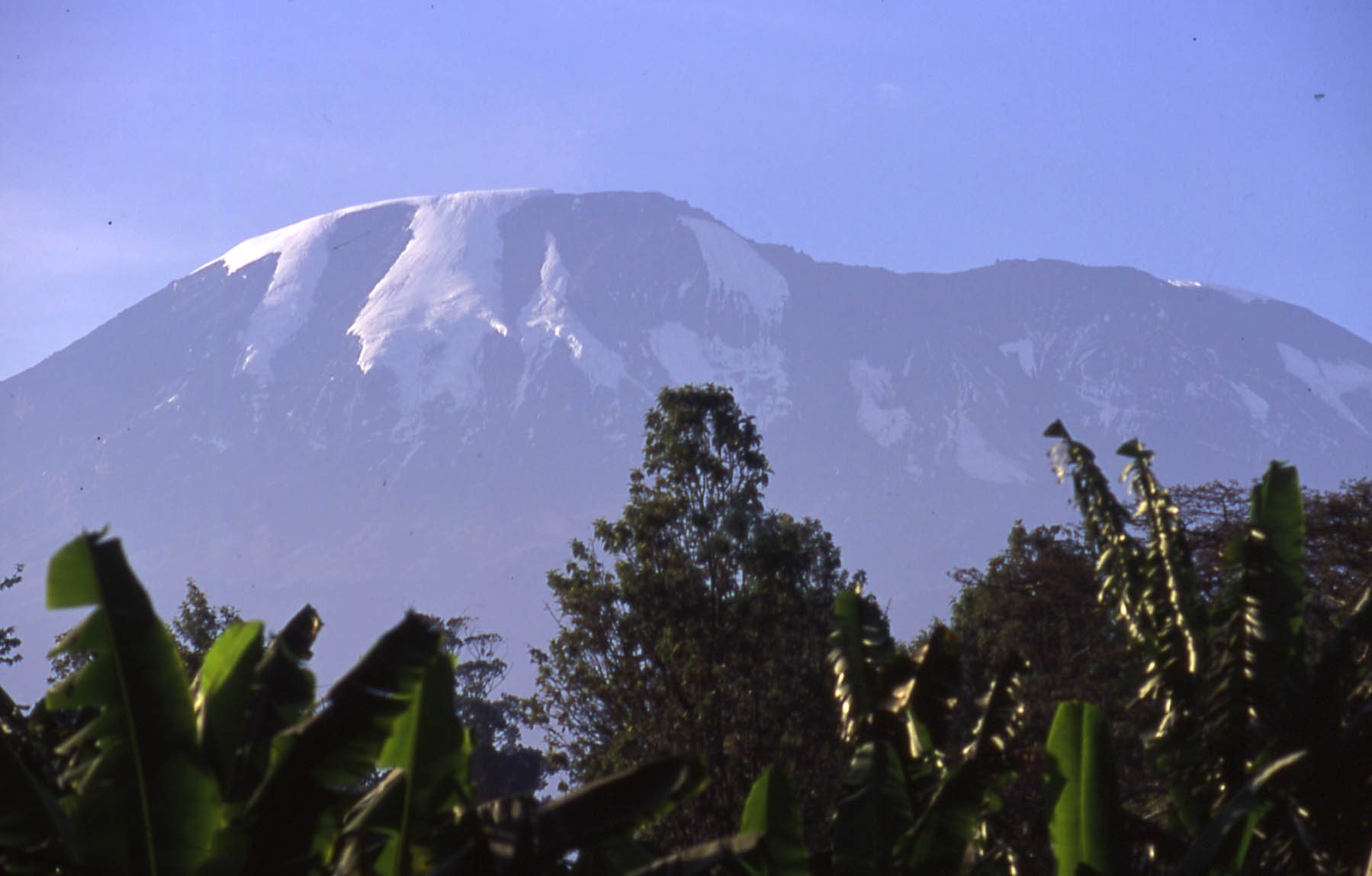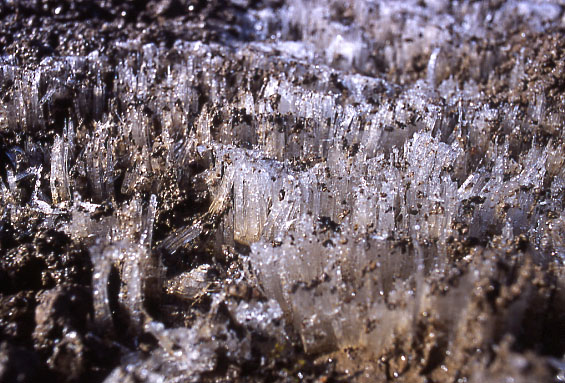Trekking Kilimanjaro
Key information: Trekking Kilimanjaro 
- The highest mountain in Africa, a spectacular, charismatic, free-standing retired volcano. Justly famous, and popular trails can be crowded.
- Pass through gorgeous and varied ecosystems, gawp and the cliffs, and glaciers of the summit area, revel in truly staggering views.
- A wide selection of routes, hutted or camping.
- This is a high, tough mountain, turning into an altitudinous slog at the end. Be prepared.
Walkopedia rating
(Top 100)
- Walkopedia rating92
- Beauty35
- Natural interest19
- Human interest3
- Charisma37
- Negative points2
- Total rating92
- Note: Negs: altitude
Vital Statistics
- Length: Variable
- Maximum Altitude: 5,896m
- Level of Difficulty: Difficult
WALK SUMMARY
At 5,896m the “roof” of Africa, and the highest free-standing mountain in the world: Kilimanjaro is spectacular, romantic and a famous “bag”; but the tens of thousands of people climbing each year make for crowds on the popular trails at busy times. You will feel triumph and exhilaration if you are one of those who reach the peak, which your altitude misery will not wholly ruin. Many, though, are too debilitated by headache, nausea or worse to manage the final ascent. This is one tough mother.
Although now dormant, Kilimanjaro is, amazingly, less than a million years old – a blink in geological terms. The vast central massif of Kibo was, until recently, covered by an ice sheet up to 100m thick – the "snows" that inspired Hemingway. The last dying glaciers are predicted to have vanished by 2040.
You can understand why Kilimanjaro has been so admired, and draws adventurers from all round the world. A view of it, towering in all its majesty above the acacia plains of East Africa, breathes life into that tired word "iconic".
You will climb through some of Walkopedia’s favourite vegetation zones: dense (and often wet) rain-then-cloud forest full of competing trees, including podocarpus, fig, hagenia and tall and spindly giant heather at the higher end, with giant ferns, thick undergrowth and flowers in clearings, including the beautiful elephant head and trunk-shaped and impatiens kilimanjari; damp giant heather festooned in trailing lichens with views out to the billowing tops of the clouds over the lowlands; gorgeous scrubby moorland; alpine desert; then rock and ice, deep into the summit complex of craters, cliffs and glaciers. We think it pretty grim above 4,500m. You will catch spectacular views across a region of natural wonders and you should spot animals of interest - eagles and buzzards will soar above but bigger game is scarce, unlike on neighbouring Mt Meru. Smaller antelope and leopards are there in the forests but you will be lucky to get a glimpse, while you may see colobus and blue monkeys and sunbirds, hornbills and turacos. You might also see the adorable Kilimanjaro shrew and chameleons at higher altitudes. The Trailblazer guide has an excellent section (with colour photos) on flora and fauna.
The summit area really is extraordinary. The south-eastern rim is a long swing of sharp rock above sheer drops on both sides, between Gilman’s Point (5,685m), where the combined paths from the Kibo Huts and the Outward Bound Hut Camp to the east(ish) meet the rim, and Stella Point where the trail from the Barafu Camp to the south arrives, and finally Uhuru Peak (5,896m) to the south-west. From Gilman’s Point, a wonderful traverse along the inside of the crater rim leads to Stella Point, although most will make it in the dark and it is in places a precipitous teeter above the cliffs and long rocky slopes down into the crater. The final hour’s breathless slog up the rim to Uhuru Peak is excruciating for most, although beautiful light, views and cloud effects may distract you at almost every step, so progress can be even slower than it need be. Kili’s crater is huge, although the picture is confused by banks of old lava filling most of the void, with a further inner crater somewhere. You can explore it, and indeed masochists can camp there. The actual peak is slightly bathetic, a nondescript hump in the ridge with a rack of boards proclaiming its statistics and a score or more of people waiting to take their photos with it. See our Kilimanjaro Summit page for detail and gorgeous photos of the summit and the ascent.
The authorities are looking after the area well: your substantial park fees are being used, with the landscape generally pristine, trails superbly maintained and campsites pretty clean considering the huge numbers visiting. It compares well with (say) Ethiopia’s Simien Mountains, where, as of 2019, campsites were pretty disgusting and park fees clearly not translating into care on the ground.
Most of the locals you will meet are from the Chagga tribe, a cheerful, friendly and independent people. Much of their traditional way of life has been overwhelmed by the influence of Western culture: some knowledge of their history is nevertheless valuable for your time with your support team. The Trailblazer guide has an excellent section (with colour photos) on flora and fauna.
Walking options and cost
There is a multitude of ways to walk on Kili, whether or not you are heading for the peak. Even if you don’t feel up to summiting, a trek across the massif, reaching around 4,000m so suffering (relatively) less, but avoiding the crowds on the motorways to the peak, is extraordinarily rewarding.
Those who want to tackle the summit should choose their route carefully: longer you take to ascend this tough mountain, the more you will enjoy your experience and the more likely you are to make the top. If you can, follow the less-used and more gradual routes. While factors such as cost and your time available will be relevant, we recommend taking a week or so to walk slowly around the mid-slopes, taking the time to enjoy the scenic and natural magnificence, and gaining acclimatization – and then tackling the summit. All routes other than the Marangu require camping, and thus a larger and more expensive expedition. (Those with the time and money could first climb Mt Meru or Mt Kenya (both demanding in their own right) as a warm-up.)
Walking on Kili costs a lot, which means people try to keep their climb short, with dire consequences for their acclimatization and thus enjoyment – and, indeed, safety – and a greater risk of not making it to the peak: many climbers are too debilitated by headache, nausea or worse to manage the final ascent. Ie, our advice is to take a longer route if your time and finances allow. Remember also that cost savings tend to come out of the pockets of the support team, so ethical travelling means avoiding the very cheapest options. The hutted Marangu Route is a (relatively) cheap option, as you need far less kit, so less support, which adds to its popularity and thus crowding. The Machame Route is the cheapest (but most-used) camping route. See more under “Practical Information” below.
Remember: Most of the routes can be extended or linked up to create longer ascents and crossings of the high shoulders of the volcano. If you are not aiming at an eventual ascent of the summit, you are even freer to choose varied and discursive routes of the (relatively) lower slopes.
It is a requirement of the Kilimanjaro National Park to have a Tanzanian guide to ensure safety and to organise suitable lodgings/camping, food and porters (you really won’t want to carry everything yourself to these heights).
Direct routes to/from the summit include:
The 5 or 6 day Marangu (or “Coca Cola”) route (from the east) is one of the shortest routes to the summit and the only one with huts all the way – and a (relative) budget option. It is heavily used, with crowded huts and a nose to bum slog at the end. It has the highest failure-rate of all the main routes. We would recommend you to avoid it if you can. You attach the summit from the Kibo Huts at 4,703m above the Saddle to the east.
The particularly beautiful 6 or 7 day Machame route (from the southwest), reaches altitude quickly, but then turns east on the Southern Circuit to take more time to get to the final ascent via the Barafu Camp, which aids acclimatisation. It is a (relative) budget option, and is as of 2020 the most popular route on the mountain.
The Mweka Route via the Barafu Camp to the south is possibly the most direct route of all to/from the Kili summit, which is largely why it is used for descent – the climb would be relentlessly tough, and poor for acclimatization. It is a beautiful and fascinating, but long (4,000m+) and steep. You will pass through varied ecosystems, from rock and ice just below the summit; to grim, craggy alpine desert amid the remains of lava flows; to sparsely beautiful scrubby moorland, then to gorgeous, damp giant heather with views out to the billowing tops of the clouds over the lowlands; to dense and exuberant forest. 1.5 days descent from the summit.
There is also the Umbwe Route from the south. This is the most direct of all the ascent routes, leading to the Great Barranco to join the Southern Circuit to wind round to Barafu Camp and thence to the summit. but is much less used as it is steeper and tougher and worse for acclimatization. You can do it in 5 or 6 days total.
Traditionally, most climbers approached from the east or south, and fought their way up in a 5 or 6 day round trip, with a lot of misery and attrition from altitude sickness. Increasing numbers are making a longer trek of it, approaching from the west to the Shira Plateau, as Walkopedia did, or on the Rongai Route from the north-east. Less direct routes towards the summit include:
The Lemosho and Shira routes climb onto the remarkable Shira Plateau in Kilimanjaro’s west, and meet at Shira 2 Camp to link into the Northern and Southern Circuits, to lead walkers round to mass of the main Kibo summit, to the ascent routes to the east and south. This makes the Lemosho Route the longest/slowest possible approach, 6 or 7 days days to the summit base if you then take the Northern Route, meaning you have a much better chance to acclimatise than on more direct routes. It is also significantly less crowded that the well-known routes. The ‘normal’ Shira Route is the same number of days as the popular Machame, and starts quite high, so, while relatively empty, actually isn’t a great option for acclimatisation if you are heading for the summit. It would be a good option if time is short and you want to get high quickly and have a night or 3 in the mid-levels to experience Kilimanjaro’s many marvels. The Shira Plateau is an extraordinary place, the caldera of the massif’s collapsed first volcano filled in by millions of years of eruption and erosion from the youthful Kibo. Its vegetation is an important part of it glory: vivid, ravishing shrub-land which seldom obscures the views, most notably of Kibo looming in icy splendour. There are some excellent side walks from the main plateau campsites: to the amazing views at Shira Cathedral and high Lava Tower in particular.
The Northern and Southern Circuits: increasing numbers are approaching from the west to the Shira Plateau, as Walkopedia did, then swinging round Kibo on the Northern and Southern Circuits to climb it on the main routes up from the east/south. The Northern Circuit used to be little-used, but has developed a lot over recent years, with good campsites, but it is still emptier than the Southern route, and that bit longer, with 4 nights before the summit as compared with the Southern Circuit’s 2 or (more usually) 3. And easier walking, with no Great Barranco to traverse. Both routes are consistently way above the tree-line, in really beautiful heathland , moorland, tundra and rocky desert. They have many delights to enjoy en route, including the Lava Tower near the junction of the routes, and Lent Hill formation above Moir Hut on the Northern Circuit.
Rongai Route: one of Kilimanjaro’s nicest approaches, this relatively remote route from the north-east has many advantages, and many beauties. It is the driest major approach, with less risk of wet and mud on the mid slopes, and good at rainier times of year. The basic Rongai is one of the most direct route of all, so is very tough, and poor for acclimatization. But you can swing east and explore the Saddle area and the base of great Mawenzi (camping at beautiful Mawenzi Tarn) before attacking the summit via the Kibo Huts on the Marangu route. This longer version is one of the easier approaches to Kili, and good for acclimatization and therefore likely summit success – as well as being beautiful. If Walkopedia got back to Kili, we would walk this route. The Rongai has a reputation for being less scenic than some other routes, but that is mainly the case for the first day: you will later climb through beautiful heather and shrublands, alpine tundra and high desert, with some of the very finest views of both soaring Mawenzi and the vast icy mass of famous Kibo. 4-5 bays to summit base.
Possibly the best route of all – if you have the time and the money to take more time in the ascent – is to climb the western flank to the Shira Plateau, then walk around the little-frequented northern slopes to the ravishing Mewenzi tarn, below Kilimanjaro’s shattered second peak, then cross the desert Saddle and attack the summit.
To explain a bit further, there are three main final walkers’ routes to the summit, which all of the above routes converge to join:
From the Kibo Huts at 4,703m above the Saddle to the east. These are on the Marangu (“Cola-Cola”) Route, one of the most popular routes to the summit, and also the “longer” Rongai. As a result they can be crowded.
From the Barafu Camp at 4,600m to the south. This is a pretty grim, huge site in a fine setting above the romantically-named South-east valley. You get here up the Machame Route, or Umbwe Route or along the Southern Circuit from the longer ways up via the western Shira Plateau. It is said that this route gets more than 80% of all summit walkers.
From the Outward Bound Hut (actually another bleak, high campsite) to the north-east. This is fed by the basic Rongai Route, and the Northern Circuit from the Shira Plateau. The path from here merges with the Marangu from the Kibo Huts, but until then you will be able to kid yourself you are in remote landscape.
There are several other routes, for tough and adventurous scramblers, including the famous Western Breach. See more at our Kili Summit page.
Altitude: the top of Kilimanjaro is unreasonably high, so this a very tough walk, potentially fatal. Acclimatize appropriately, come prepared to cope, be ready to evacuate people in extreme cases. Altitude stops over half of those who attempt the summit on shorter approaches (ie, don’t be depressed if the altitude still defeats you), and kills in most years. It is unpredictable and can strike the fit, tough and experienced. Remember: the slower you ascend throughout your time on Kili, the less miserable it will be at the end. Get fit, be prepared, keep hydrated and obey your guide. If he tells you to stop/descend, do so. Watch your friends for signs of acute mountain sickness (AMS).
(A note on Walkopedia’s rating for walking here: Kili patriots will be shocked that the final ascent of this famous mountain does not make our Top 100. In the end, however, drama and boasting rights do not compensate for the miseries of life at well over 19,000ft. We rate various of the other walks in this amazing place higher (and will lower altitude negatives), which justify the massif’s place in our Top 100.)
Best book: Kilimanjaro – The Trekking Guide: Henry Stedman for Trailblazer. We really like this: excellent route descriptions and photos, and very clear about what is a complex and multi-optioned mountain: especially helpful is its condensed summary of the different options. We also like the history of the mountain and discussion and pictures of the fauna and flora.
www.tourdust.com organise an expedition here : we have travelled with Tourdust, and were delighted. They were very nice and flexible to deal with, and evidently cared about quality, as their walk was meticulously prepared and our support team were outstanding in every way. We are proud to be their partners.
WILLIAM MACKESY'S ACCOUNT
of this walk
WM’s Kili walk, March 2020 (Lemoshso Route, Northern Circuit, Summit, Mweka Route)
Lemosho Route
Day 1: To Forest camp
Driving in to the start of a Kili trail is a fantastically enticing experience: from the plains, the great mass looms vast and serenely white-capped amidst its cloudy robings, its scale deceptive, above the plains and forested lower slopes.
Approaching from the west, the road begins to climb, and the lush farmland turns to scrubby grassland littered with fumeroles, then rich dark farmland.....
READ MOREOther accounts: share your experiences
Your comments on this walk, your experiences and suggestions, and your photos are very welcome. Where appropriate, you will be credited for your contribution.
We have a lot of helpful practical information and tips about this walk, covering everything from the best books and maps, to timing and weather, geting there, possible problems, whether you need a guide and where to find them, and useful websites. This section is only open to members.
Membership is FREE AND JOINING TAKES 30 SECONDS. To login or sign up click here
Safety and problems: All walks have inherent risks and potential problems, and many of the walks featured on this website involve significant risks, dangers and problems. Problems of any sort can arise on any walk. This website does not purport to identify any (or all) actual or potential risks, dangers and problems that may relate to any particular walk.
Any person who is considering undertaking this walk should do careful research and make their own assessment of the risks, dangers and possible problems involved. They should also go to “Important information” for further important information.
Anyone planning an expedition to this place should see further important information about this walk.
Safety and problems: All walks have inherent risks and potential problems, and many of the walks featured on this website involve significant risks, dangers and problems. Problems of any sort can arise on any walk. This website does not purport to identify any (or all) actual or potential risks, dangers and problems that may relate to any particular walk.
Any person who is considering undertaking this walk should do careful research and make their own assessment of the risks, dangers and possible problems involved. They should also go to “Important information” for further important information.
OTHER ACCOUNTS
share your experiences
Add your experiences, suggestions and photos. We would be delighted to receive your writing and ideas (which will be attributed appropriately where published).
Anyone planning an expedition to this place should see further important information about this walk.
Responsible travel matters, a lot. How you travel will make a real difference - for better or worse. PLEASE consider this when making plans. Read more



